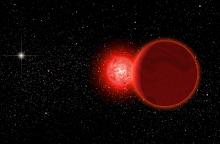Listen to today's episode of StarDate on the web the same day it airs in high-quality streaming audio without any extra ads or announcements. Choose a $8 one-month pass, or listen every day for a year for just $30.
You are here
Moon, Venus, Aldebaran
The Moon passes through some crowded territory the next couple of nights. Its most prominent companion is Venus, the beautiful “evening star.” Venus is close to the upper left of the Moon tonight. And a bright true star is a little farther to the left of the Moon: Aldebaran, the bright orange eye of Taurus, the bull.
And here’s something interesting about the trio — and about every other object in the night sky. We see all of them at the same moment in our own timeline — but not in theirs. We see the Moon, Venus, Aldebaran, and everything else as they looked at different moments in the past.
That’s because the universe has a speed limit — the speed of light. It’s 670 million miles per hour. But this speed limit is enforced by the laws of physics, so there’s no way to cheat and squeeze in a little extra.
As a result, it takes time for light to travel from a star or planet to our eyes. And the amount of time depends on its distance.
The Moon, for example, is a little less than a quarter of a million miles away, so the sunlight reflected from its surface takes about one and a third seconds to reach us.
Venus is almost a hundred million miles away right now — almost nine minutes at lightspeed. And Aldebaran is four million times farther than that. It takes light 65 years to cross that immense gulf — a distance of 65 light-years.
We’ll have more about the Moon and its companions tomorrow.
Script by Damond Benningfield






